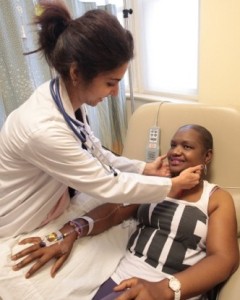

Art used with permission of Helen Osborne who created Health Literacy Month and www.healthliteracymonth.org
Editor’s introduction: A serious gap exists between what providers intend to convey and what patients and families understand.The fact is the lack of health literacy costs the U.S. more than $100 billion annually, according to the Victor Dzau, president of the Institute of Medicine. Speaking at the IOM’s Roundtable on Health Literacy, which was convened this year to assess the current and future state of health literacy, Dzau stressed that efforts to reduce health literacy must focus not just on helping patients learn more, but also on aligning health systems so that they communicate information in a health-literate manner. “We need to make sure that we respect people’s skills, abilities, and values so they can maximize the learning they can have and understand the choices they need to make,” Dzau said.
One of the underlying challenges in communicating with patients and families is dealing with cultural differences. Just 14 months ago, Dr. Mauvareen Beverley addressed the topic here on our blog, sharing the insights she gained from building cultural competence within her organization. In case you missed it, we bring you this “Encore Performance.”
Healthcare systems are evolving with the expectation that patients and families are collaborative partners in the overall plan of care. A major focus for providers is changing patient’s behavior in order to improve access, decrease cost, prevent readmission and improve health outcomes. A significant, if underappreciated, factor in this new order is the ability for healthcare professionals to successfully enact change in their patients. Indeed, the approach of healthcare professionals can have a positive or negative impact on patient care, compliance and the patient experience, self-management, health outcomes, readmission and adverse events. In this environment, leading organizations are seeking to align patient engagement and cultural competency, which will decrease judgmental behavior directed at patients, lessen disparate care, and improve health outcomes for individuals.
The Common Thread
Amid diversity, what do patients have in common? They don’t have choices about their diseases. Once accurately diagnosed, the disease is NON-NEGOTIABLE, meaning they can’t give the disease back, and may remain with the individual for life. Patients may be forced to change their lifestyle or job as a result of this non-negotiable disease. There may be temporary or permanent loss of control over one’s life, and at any point in our lives, we as health professionals can become patients.
Fear Factor
When an individual is diagnosed with a disease or condition, fear is often the first reaction. Patients may question treatments, quality of life, even their mortality. Family members may despair about the ongoing need for treatment and resources, administering medications, or the future outlook of their family. Medication side effects may elicit more fear and discomfort than the disease itself. Often, patients may not understand drug regimens or cannot afford costly prescriptions and may be deemed “noncompliant” and perceived as not caring about their own health.
Redesign a Negative Culture of ‘No’
When we use negative language such as “non-compliant” without asking the question, “Why,” it may lead to poor health outcomes. Common phrases that label “non-compliant” patients may include: frequent flyer, high utilizer, drug seeker. Do these terms dehumanize patients? Does negative labeling increase healthcare cost? Does it correlate to a lack of empathy, constructive dialogue, and a willingness to educate patients?
Who are the patients at various hospitals, private practice and community health centers? Not only are they English speaking and American born, they are from different countries, speak several languages, and may have different religious beliefs, have different expectations regarding their healthcare needs and the role of healthcare providers, and may have different beliefs about the use of Western medicine versus herbal and/or home remedies.
Cultural competency is defined as the ability of providers and organizations to effectively deliver healthcare services that meet social, cultural, and linguistics needs of patients. A culturally competent healthcare system can help improve health outcomes and quality of care, and can contribute to the elimination of racial and ethnic health disparities.
The possibility of the disease being a lifelong burden requires major lifestyle changes and there is a major need to understand where the patient is in acceptance of the disease. Patient centered care should start with understanding your patient, giving them the benefit of the doubt, being non-judgmental, and being empathetic. Eliminate the use of negative labels such as high utilizers, drug seekers, frequent flyers and non-compliant without knowing or asking “why.”
Understand Patient Differences
Patient engagement is not about broad brushing a disease to a group of individuals. Defining an individual primarily by a disease may actually limit healthcare professionals from getting to know and successfully treat an individual. Get to know the individual in his or her own “personal space” to better partner with patients and families in improving their health. It’s important to remember that the individual has the disease; the disease does not have the individual.
Organizational Philosophy
Recently, at Kings County, Patient Engagement and Cultural Competence Training became mandatory for all staff. To administer culturally competent clinical and nonclinical care, it is important to understand the institution’s perceptions about their patients, the communities they serve, and transform the perceptions into reality, change attitudes and mind set, become empathetic, non-dismissive and non-judgmental. Recognize the role of history, religion and beliefs and align cultural competence with patient value, patient engagement, communication, and respecting the decision-making capacity of patients and families. There also has to be a willingness to listen and understand the individual’s cultural beliefs and include it in the health dialogue. Avoiding judgmental behavior is the key to improving the patient experience.
Ask Key Questions
It is important to think “outside the box” in order to improve the patient experience. Ask yourself the following questions:
What is the patient not saying that as a healthcare provider I am not hearing? You may hear:
- I am embarrassed to talk about my living arrangement; I have not accepted the disease
- I don’t understand what you are saying; I can’t afford the medications; I am scared to death about my condition
- I am worried about the impact on my job and finance
- I don’t trust the medicines
- I’m going to try home remedies
What is the physician, nurse, social worker or care manager not saying that the patient is hearing?
- I am not smart enough to understand my disease
- I am in the low literacy group, therefore I have low intelligence capability
- You don’t think I am going to follow your instructions
- You don’t see the need to value and understand my cultural beliefs
- You don’t see me as valuable as you
The result is that patients may not receive the empathy, time and resources to help improve their health. Try to maintain patient dignity while asking probing questions about medical history, personal habits and behaviors.
- Assess body language
- Be more astute, empathetic and non-judgmental
- Be conscious about the time required for an individual to come to terms and accept his or her disease
- Understand that patients have no choice but to accept their diagnosis and they may need help coping with the disease and its impact on their lives and the lives of their loved ones
- Have patients define and prioritize what is important to them, evaluate how the disease or illness and its management fits into the patient’s priority list
- Design an individualized care plan focused on the patient’s time frame for acceptance of disease and readiness for self-management
- Continue to provide support and encouragement to patients as needed
- Remember an individual with his or her complexities came to a healthcare setting and left as a “patient”
What Have We Learned?
Behavioral change starts with health professionals. Professionals and patients share the same human concerns and emotions. We all can be patients at any given point in time, and when that happens, the illness trumps ethnicity, race, gender,and culture. Historical baggage can influence patient behavior. Terms such as frequent flyers, noncompliant and abusers used over time in a healthcare setting toward patients can potentially create a culture of callous disregard. A culture of disregard can negatively impact patient health and safety and thus affect patient compliance. Vital to remember is the fact that we all can become patients at any given point in time.
Editor’s Note: You can read more about Kings County Hospital Center’s success in aligning patient engagement and cultural competence in their 2014 nomination for the John Q. Sherman Award for Excellence in Patient Engagement.
You can download a free copy of the IOM report, Health Literacy: Past, Present, and Future: Workshop Summary here.






7 Comments
Dr Beverley’s reflexions are poignant. It challenges us to understand that when our “Humanity” drives our knowledge, decisions, and actions we will learn to see the “Humanity” in others, so that we can respect our differences even when we don’t embrace them. Let us find dignity, respect and compassion to care for our patients by first recognizing this inextricable bond.
Dr. R. Austin.
Dr Beverley`s article points out fundamental approach to patient engagement that is a must read for healthcare professionals involved in patient care. Everybody currently is talking about patient centered care but only few people think outside the box. The article is a masterpiece which challenges us to think outside the our quest to provide culturally competent care. Great Kudos to Dr Beverley
Dr A. Umeozor
It seems absolutely paramount for healthcare providers across the nation to acknowledge and embrace the diversity that exists in the population. Dr. Beverley alluded to some important points on ways to address the challenges posed by operating in a multi-cultural environment. Negative culture could be replaced with a dynamic model where cultural differences are recognized, and this article elaborates on ways to achieve this goal. Very informative article Dr. Beverley; couldn’t have written it any better.
B. Bankole, RN, MSN.
Dr. Beverly makes several excellent points which we are using in the education of our medical students during their “pre-clinical” years. The earlier these issues are appreciated, and the skills acquired, our soon-to-be-physicians will be ahead of the pack and our patients better off for their empathic skills and cultural competence.
Dr. Beverley has eloquently discussed the essentials of developing a trusting, non-judgemental patient-doctor relationship. Doctors cannot forget the value of getting to know your patient and not just treating the disease. It is so true that engaging the patient and asking “Why” can go along way in successfully treating your patient. This article is so appropriate in its emphazing the importance of cultural diversity, health literacy and empathy in the healthcare profession…Read and reflect.
Picture yourself on the other side of the examining table. Now, picture yourself trying to understand the physician who not only does not speak your native language, but also comes from a different culture that does not have the same values and concerns that shaped your development. Can you trust this physician? Can you understand the recommendations? What will my family think? Will my friends shun me?
As physicians, we must bridge these gaps every day to reach our patients and fully engage them in the understanding and management of their disease processes. Dr. Beverley eloquently describes this cultural gap and its impact on the effectiveness of the healthcare we deliver. Some tips on how to successfully bridge this cultural chasm are eloquently described. An essential read.
Great read, Dr. Beverley. As the U.S. healthcare system continues to be shaped by technological advances, it is easy for the culture of our healthcare system to shift away from treating the whole person and toward “fixing” the disease. This article is a good, necessary reminder that respecting sociocultural and linguistic differences is at the root of treatment compliance and ultimately, minimizing the fiscal burden on the U.S. healthcare system. More importantly, isn’t treating the patient for who they are just the humane thing to do?